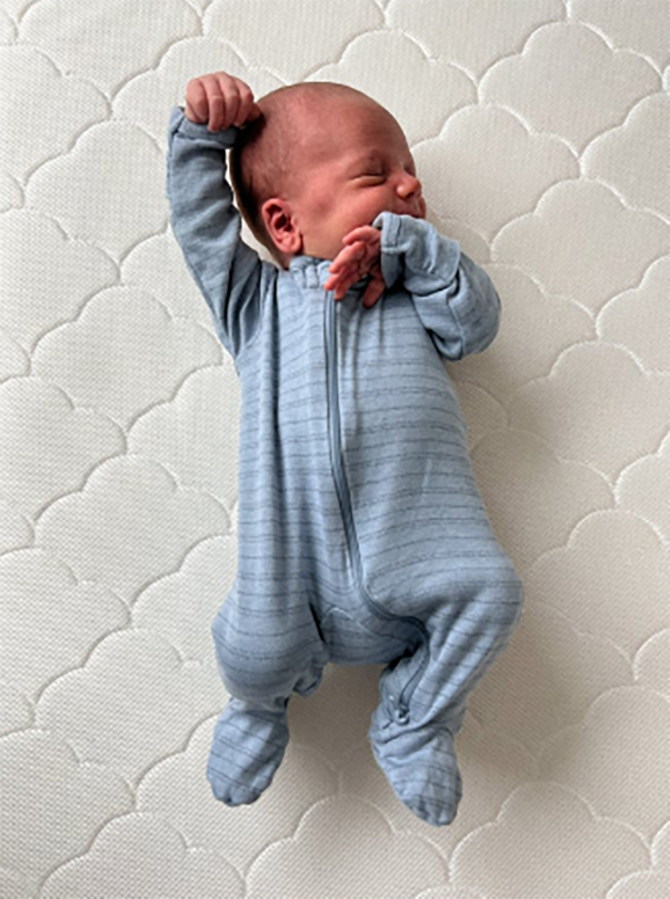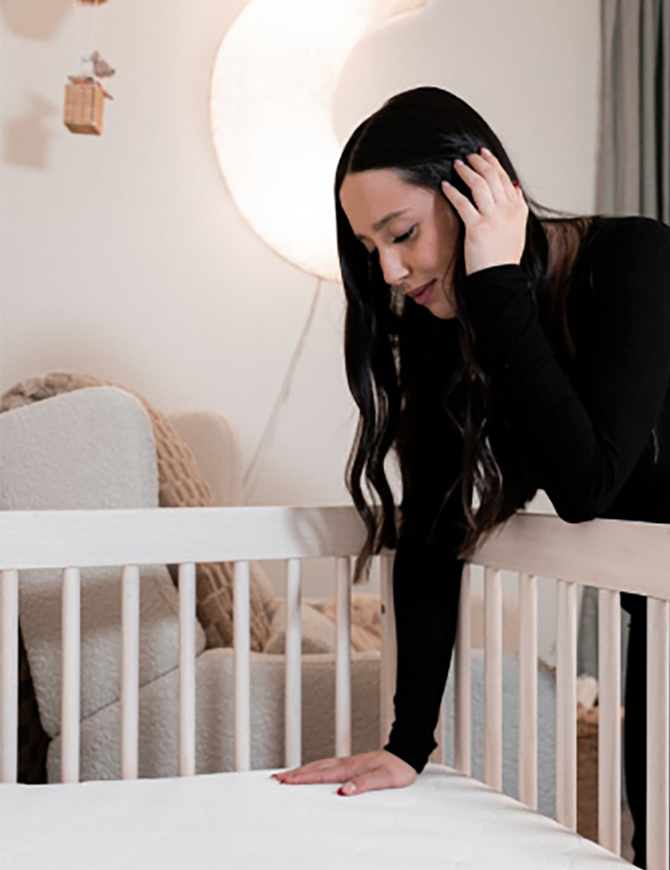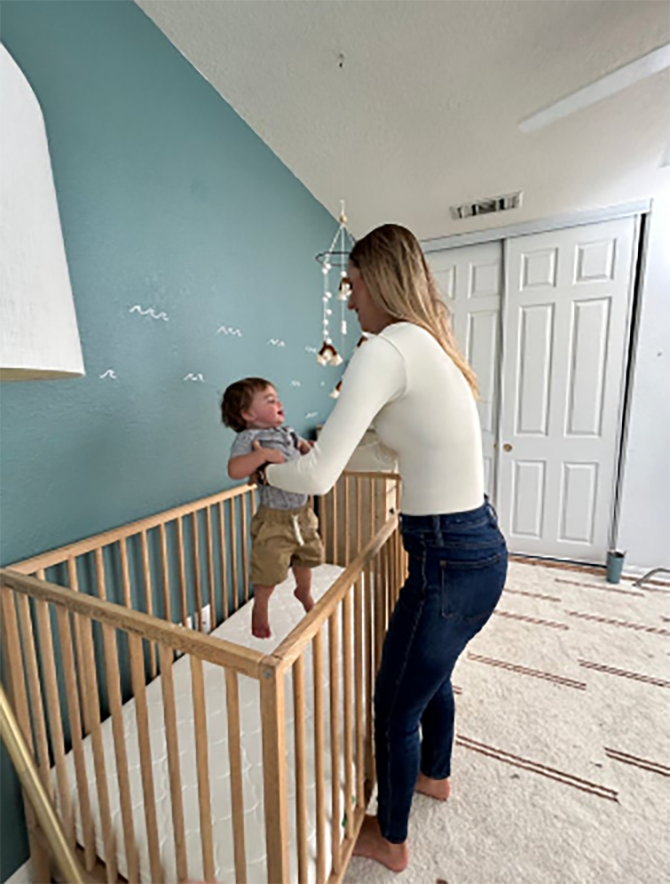
A stuffy nose is uncomfortable for all of us, and it’s even worse for our little ones. To get better, they’ll need plenty of rest. That’s why finding the best sleeping position for a baby with a stuffy nose is key.
In this article, we’ll tell you how to know if your baby is suffering from congestion, what might be causing it, and the best sleeping position for them. We’ll also give you a few tips to help relieve the stuffiness so that, soon enough, they’ll be breathing easy again.
Table of contents
- What causes a stuffy nose?
- How to tell if your baby has a stuffy nose
- Best sleeping positions for baby with stuffy nose: On their back
- Best sleeping positions for baby with stuffy nose: Safe sleep tips
- Ways to help baby’s stuffy nose
- When to see a doctor
What causes a stuffy nose?
Your little one’s stuffy nose is triggered by anything that inflames or irritates their nasal tissues, causing mucus to accumulate in their nose and airways. This nasal congestion is most commonly caused by viruses, including RSV and the flu.
Although it’s uncomfortable, there’s actually a good reason for it: it’s their body’s way to battle viruses, allergens, and pollutants. The mucus keeps your baby’s nose moist and free of irritating particles.
Stuffy noses are very common for babies, and unless it goes on for a prolonged period or they are having difficulty breathing, you needn’t be overly concerned. If it is more severe or if they’re under three months, it’s best to see your doctor right away.
How to tell if your baby has a stuffy nose
Because your little one can’t tell you their symptoms, you’re going to have to rely on what you see. Here are some signs of a stuffy nose to look out for.
Thick mucus
One obvious sign that your baby has a stuffy nose is thick mucus in and around their nose. This, as we said, is their body’s way of fighting against a foreign invader, be it a virus, pollutant, or allergen.
Discolored mucus
Mucus is normally clear, so if your little one has yellow or green mucus, it may be a sign of a viral or bacterial infection.
Coughing
The mucus responsible for inflaming the tissues and blood vessels in your baby’s nose can also seep down into their throat, triggering a cough.
Snoring or noisy breathing
If your little one is snoring while they sleep or breathing noisily while they’re awake, it may be a sign of a stuffy nose.
Difficulty eating
Your little one may also have a hard time eating when they have a stuffy nose, as their blocked nose means they need to rely on their mouth to breathe.
If your little one is experiencing any of these symptoms, they likely have a stuffy nose.
Best sleeping position for baby with stuffy nose: On their back

As you’ve probably learned by now in your parenting journey, sleep is essential, so it’s important to know the best sleeping position for a baby with a stuffy nose. That’s easy: Your baby should always be placed in bed on their back.
It may feel tempting to place them on their side or on an elevated surface to allow the mucus to drain, but doing so is dangerous and must be avoided.
Safe sleep tips
Now that you know the best sleeping position for a baby with a stuffy nose, it’s important to review safe sleep recommendations in general.
Here are some tips on how to keep their shuteye safe while they’re stuffed up.
Keep the crib clear.
As cute as it is to have a crib with toys or blankets, if you have a baby under 12 months, you need to live by the mantra “bare is best” when it comes to their sleep surface.
Only put your baby to bed in safe sleep spaces.
You also want to remember that your little one should only sleep in a crib, travel crib, or bassinet. It may feel tempting to allow them to slumber wherever their eyes shut, especially if your little one has a stuffy nose, but doing so can be dangerous.
If they nod off next to you on the couch or in a baby rocker, move them to their proper crib as soon as possible.
Make sure their mattress is firm and breathable.

So that your baby gets restful and safe sleep so that can kick their stuffy nose ASAP, you’ll want to be sure their mattress is firm and breathable. If their mattress is too cushy, it can be dangerous.
As for breathability, it’s important because babies cannot thermoregulate on their own and can overheat easily. A breathable mattress will help with the natural airflow.
Also, if they flip over during the night, with a breathable mattress they can just breathe right through. Newton Baby’s Essential Crib Mattress is not only firm and breathable but also 100% washable, making it a great choice for a peaceful night.
Share a room, not a bed.
It seems like a sweet thing — fall asleep snuggling with your little one — but doing so can be dangerous. Instead of sharing a bed, share a room. With your baby in a bassinet and you in the bed close by, you can bond and snooze safely.
What’s more, room-sharing for the first six months (and even better, the first year) has been associated with a decreased chance of SIDS.
Dress them for the room’s temperature.
When you put your baby down, you want to be sure they’re dressed appropriately for however warm or cool the room is. The rule of thumb is to dress them in one layer more than you would wear yourself.
Make sure they have an optimal sleep environment.
Getting restful sleep has a lot to do with your little one’s sleep environment, so you want to be sure they have a dark and quiet room.
Blackout shades can help with the light, and if there’s too much outside noise that might disturb them, think about getting a white noise machine.
Maintain a consistent bedtime routine.
To get your baby sleeping as well as they can while they have a stuffy nose, try to maintain your regular bedtime routine. Your little one will start recognizing the steps and their body will start relaxing and anticipating sleep.
Before putting them to bed on their back (the best sleeping position for a baby with a stuffy nose), try to clear their congestion using some of the ways we’ve listed below.
Ways to help baby’s stuffy nose

The best thing you can do for your little one if they’re congested is to clear the mucus from their nose. As their nasal passages and lungs are still so small, they can’t do it on their own.
Here are some ways that you can help your little one feel more comfortable day and night.
Carry your baby upright.
Although we know the best sleeping position for a baby with a stuffy nose is on their back, during the day, carrying them upright will help their sinuses drain. Using a baby carrier is an easy and hands-free way to do this.
Keep them hydrated.
Hydration will help thin the mucus that’s blocking your little one’s airways.
Try saline drops.
Putting a few drops of saline in each nostril will also thin the mucus and help your baby breathe more easily.
Suction gently.
Removing the mucus using a nasal aspirator should clear your baby’s nose for a while.
Use a cool-mist humidifier.
As dry air can cause congestion, adding moisture to the air can help clear your little one’s stuffy nose.
Sit in a steamy bathroom.
Sitting with your baby in a steamy bathroom can also do the trick of temporarily clearing their nasal passages. Make it brief, though — no more than three to five minutes — and if they seem uncomfortable, stop.
Give them a facial massage.
A gentle facial massage can help loosen what’s clogging your baby’s sinuses. Use two fingers to gently massage around their eyebrows and nose.
When to see a doctor
If your baby’s symptoms don’t clear up quickly or are worsening, head to your pediatrician’s office right away. Here are some signs you want to go see your doctor:
- Baby is under three months
- They have trouble inhaling
- They make high-pitched sounds when breathing
- They have a fever
- They have persistent trouble feeding
- They have had congestion lasting over four days
- They are dehydrated
Breathe easy, baby.

Sleep is essential for your baby’s road to recovery, and now you know that the best sleeping position for a baby with a stuffy nose is flat on their back.
When you’re putting your sweetie to bed, Newton Baby’s firm and breathable mattresses — like our Original, Waterproof, and Essential models — are great choices. They feature Breathe-Thru Technology and are 100% washable and hypoallergenic.
With the tips in this article and a Newton Baby mattress, your congested little one will be breathing easy in no time.
